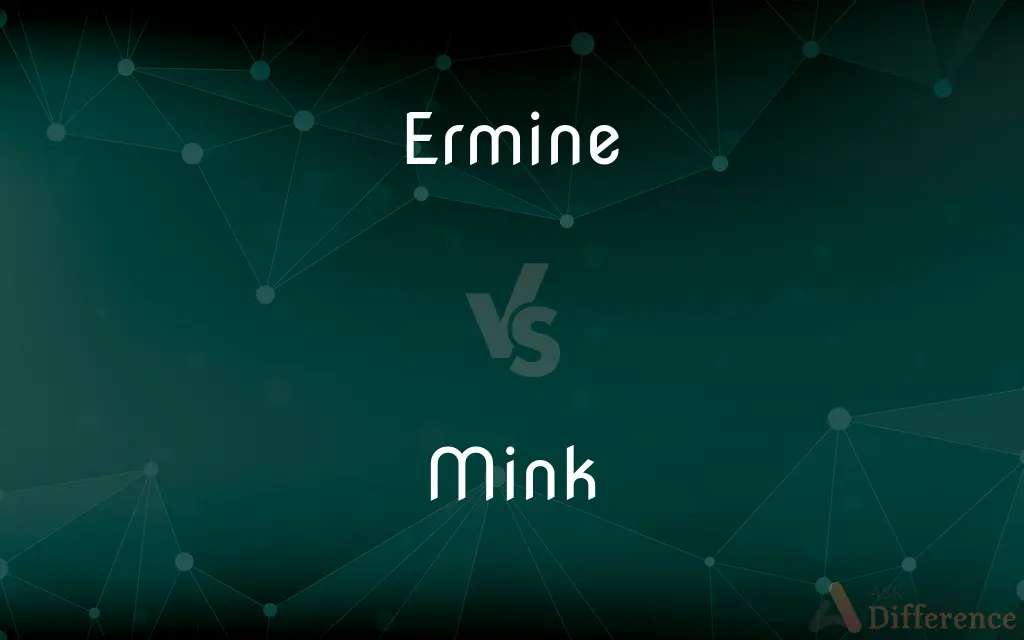Ermine vs. Mink — What's the Difference?
By Urooj Arif & Maham Liaqat — Updated on March 11, 2024
Ermine and mink are both small, carnivorous mammals known for their luxurious fur, but ermine is typically associated with colder climates and turns white in winter, while mink retains a dark fur year-round.

Difference Between Ermine and Mink
Table of Contents
ADVERTISEMENT
Key Differences
Ermine and mink are part of the Mustelidae family, which includes weasels, otters, and ferrets. Both are prized for their fur but serve different symbols in history and culture. Ermines, also known as stoats in their summer coat, inhabit colder regions and are renowned for their white winter fur, often used historically in royal garments and symbols of purity. Minks, on the other hand, are mostly known for their dense, water-repellent dark fur, widely used in the fashion industry.
Ermines undergo a remarkable transformation from a brown summer coat to a white winter coat, helping them blend into snowy landscapes, whereas minks maintain a consistent dark brown fur throughout the year. This adaptation showcases the ermine's specialized survival strategy in environments with significant seasonal changes, while minks, adapted to both terrestrial and aquatic environments, rely on their dense fur for insulation without a need for such dramatic color changes.
In terms of habitat, ermines are more widely distributed across the northern hemisphere, thriving in forested and tundra regions where their camouflage helps in hunting and evading predators. Minks are found in similar regions but have a stronger preference for wetlands, rivers, and lakes, where their semi-aquatic nature allows them to hunt both in water and on land.
Both ermines and minks are solitary and territorial animals, but ermines are known for their agility and ability to take down prey larger than themselves, including rabbits. Minks, while also capable hunters, often focus on smaller mammals, fish, and birds. Their aquatic abilities make them formidable predators in their chosen habitats.
Despite their similarities, ermines and minks face different threats; ermines are less impacted by habitat loss due to their ability to thrive in a wide range of environments, whereas minks, especially the American mink, have suffered from habitat destruction and pollution. Furthermore, the introduction of American minks to non-native habitats has led to ecological imbalances, affecting local wildlife.
ADVERTISEMENT
Comparison Chart
Fur Color
White in winter, brown in summer
Consistently dark brown or black
Habitat
Forests, tundra, across Northern Hemisphere
Wetlands, rivers, lakes, primarily in North America and Europe
Prey
Larger mammals (e.g., rabbits)
Smaller mammals, fish, birds
Aquatic Ability
Less pronounced
Highly adapted to aquatic environments
Threats
Less impacted by habitat loss
Habitat destruction, pollution, ecological imbalance when introduced to non-native areas
Compare with Definitions
Ermine
Capable of changing fur color seasonally.
In summer, the ermine's fur turns brown, blending with the forest floor.
Mink
Semi-aquatic, adept at hunting in water.
Minks use their webbed feet to navigate and hunt in rivers.
Ermine
A symbol of purity in historical and royal contexts.
Ermine fur was used to line the cloaks of royalty.
Mink
A small, dark-furred mammal valued for its luxurious coat.
Mink coats have been a staple in the fashion industry for decades.
Ermine
A small carnivorous mammal known for its white winter fur.
The ermine's white coat camouflages it against the snow.
Mink
Inhabits wetlands and aquatic environments.
Minks build their dens near rivers and lakes.
Ermine
Adaptable to cold climates with significant seasonal changes.
Ermines thrive in environments where winter brings a blanket of snow.
Mink
Suffers from habitat destruction and pollution.
Mink populations have declined in areas heavily impacted by pollution.
Ermine
Agile hunters capable of taking down larger prey.
Ermines are known for their ability to hunt rabbits much larger than themselves.
Mink
Introduced species causing ecological imbalances.
American minks have disrupted local ecosystems in Europe.
Ermine
A weasel (Mustela erminea) native to northern regions, having a black-tipped tail and dark brown fur that in winter changes to white. Also called stoat.
Mink
Mink are dark-colored, semiaquatic, carnivorous mammals of the genera Neogale and Mustela and part of the family Mustelidae, which also includes weasels, otters, and ferrets. There are two extant species referred to as "mink": the American mink and the European mink.
Ermine
The commercially valuable white fur of this animal.
Mink
Either of two semiaquatic mustelid carnivores, Mustela lutreola of Europe or Neovison vison of North America, having a pointed snout, short legs, and partly webbed toes. The North American species is bred for its commercially valuable fur.
Ermine
A weasel found in northern latitudes (Mustela erminea in Eurasia, Alaska, and the Arctic, Mustela haidarum in Haida Gwaii, Mustela richardsonii in the rest of North America); its dark brown fur turns white in winter, apart from the black tip of the tail.
Mink
The soft thick lustrous fur of a mink.
Ermine
The white fur of this animal, traditionally seen as a symbol of purity and used for judges' robes.
Mink
A coat, stole, or hat made of this fur.
Ermine
The office of a judge.
Mink
(plural mink or minks) Any of various semi-aquatic, carnivorous mammals in the Mustelinae subfamily, similar to weasels, with dark fur, native to Europe and America, of which two species in different genera are extant: the American mink (Neovison vison) and the European mink (Mustela lutreola).
Ermine
(tincture) A white field with black spots.
Mink
(plural mink) The fur or pelt of a mink, used to make apparel.
Ermine
Any of various moths, especially in the family Yponomeutidae
Mink
(plural minks) An article of clothing made of mink.
Ermine
(tincture) In blazon, of the colour ermine (white with black spots).
Mink
(plural minks) An individual with poor personal hygiene; a smelly person.
Ermine
To clothe with ermine.
Mink
A carnivorous mammal of the genus Mustela (foremrly Putorius), allied to the weasel. The European mink is Mustela lutreola. The common American mink (Mustela vison) varies from yellowish brown to black. Its fur is highly valued. Called also minx, nurik, and vison.
Ermine
A valuable fur-bearing animal of the genus Mustela (M. erminea), allied to the weasel; the stoat. It is found in the northern parts of Asia, Europe, and America. In summer it is brown, but in winter it becomes white, except the tip of the tail, which is always black.
Mink
The fur of the mink{1}. Together with sable, it is one of the most expensive furs not taken from endangerd species. When the fur is taken from animals grown on a farm, it called ranch mink.
Ermine
The fur of the ermine, as prepared for ornamenting garments of royalty, etc., by having the tips of the tails, which are black, arranged at regular intervals throughout the white.
Mink
The expensive fur of a mink
Ermine
By metonymy, the office or functions of a judge, whose state robe, lined with ermine, is emblematical of purity and honor without stain.
Mink
Fur coat made from the soft lustrous fur of minks
Ermine
One of the furs. See Fur (Her.)
Mink
Slender-bodied semiaquatic mammal having partially webbed feet; valued for its fur
Ermine
To clothe with, or as with, ermine.
The snows that have ermined it in the winter.
Ermine
The expensive white fur of the ermine
Ermine
Mustelid of northern hemisphere in its white winter coat
Common Curiosities
Why are ermines considered symbols of purity?
Historically, their white winter fur was associated with purity and used in royal regalia.
What are ermines and minks?
Ermines and minks are small, carnivorous mammals known for their fur, belonging to the Mustelidae family.
What do minks eat?
Minks diet includes smaller mammals, fish, and birds, utilizing their aquatic hunting skills.
Why are American minks considered invasive in Europe?
American minks disrupt local ecosystems in Europe, preying on native species and competing for resources.
How do ermines adapt to winter?
Ermines adapt to winter by changing their coat color from brown to white for camouflage in snow.
Is there a difference in the aquatic abilities of ermines and minks?
Yes, minks are more adapted to aquatic environments compared to ermines.
Are ermines endangered?
Ermines are not currently considered endangered, but their populations are monitored for impacts from human activities.
What is the significance of mink fur in fashion?
Mink fur has been highly valued in the fashion industry for its luxurious texture and warmth.
Are minks good swimmers?
Yes, minks are semi-aquatic and are excellent swimmers, thanks to their webbed feet.
Can ermines and minks be found in the same habitat?
While they share similar habitats, ermines prefer colder, forested areas, and minks thrive near water bodies.
Do ermines change their fur color all year?
Ermines change their fur color seasonally, turning white in winter and brown in summer.
What threats do minks face?
Minks face threats from habitat destruction, pollution, and the consequences of being introduced to non-native environments.
What role do wetlands play for minks?
Wetlands provide essential habitat for minks, offering abundant food sources and shelter.
How do ermines hunt?
Ermines are agile hunters, capable of taking down prey larger than themselves, such as rabbits.
Can mink fur change color like ermine fur?
No, mink fur remains consistently dark throughout the year, unlike the ermine's seasonal color change.
Share Your Discovery

Previous Comparison
Justified vs. Unjustified
Next Comparison
Crest vs. CombAuthor Spotlight
Written by
Urooj ArifUrooj is a skilled content writer at Ask Difference, known for her exceptional ability to simplify complex topics into engaging and informative content. With a passion for research and a flair for clear, concise writing, she consistently delivers articles that resonate with our diverse audience.
Co-written by
Maham Liaqat













































